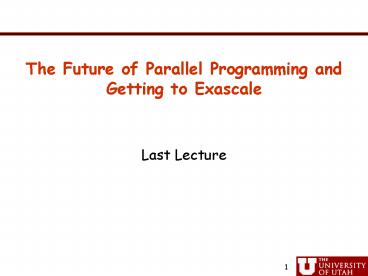Last Lecture PowerPoint PPT Presentation
Title: Last Lecture
1
The Future of Parallel Programming and Getting
to Exascale
- Last Lecture
2
The Fastest Supercomputers in the World
Name Reign Location What processors? How many? How fast?
Titan NEW Oak Ridge National Laboratory, USA AMD Opterons and Nvidia Keplers 560,640 cores, half GPUs 17.6 PFlops
Sequoia (IBM BG/Q) 2012 Lawrence Livermore National Laboratory, USA IBM Power BGC (custom) 1,572,864 cores 16.3 PFlops
K 2011 Riken, JAPAN SPARC64 processors 705,024 cores 10.5 PFlops
Tianhe-1A 2010 National Supercomputing Center, CHINA Intel Xeon and Nvidia Fermis 186,368 cores 2.57 PFlops
Jaguar (Cray XT5) 2010 Oak Ridge National Laboratory, USA AMD 6-core, dual-processor Opterons 37,000 processor chips (224,162 cores) 1.76 PFlops
RoadRunner 2009 Los Alamos National Laboratory, USA AMD Opterons, IBM Cell/BE (Playstations) 19,000 processor chips (129,600 cores) 1.1 PFlops
See www.top500.org
3
Top 5 Performance and Power (3 use Nvidia
GPUs)from GPU Computing To Exascale and
Beyond, Bill Dally, SC10
Cray XT5
Cray XT5
4
DARPA Exascale Technology Reports
See http//users.ece.gatech.edu/mrichard/ExascaleC
omputingStudyReports/ECS_reports.htm
- L/R picture
5
Getting to Exascale
- Before 2020, exascale systems will be able to
compute a quintillion operations per second! - Scientific simulation will continue to push on
system requirements - To increase the precision of the result
- To get to an answer sooner (e.g., climate
modeling, disaster modeling) - The U.S. will continue to acquire systems of
increasing scale - For the above reasons
- And to maintain competitiveness
- A similar phenomenon in commodity machines
- More, faster, cheaper
6
Exascale Challenges Will Force Change in How We
Write Software
- Exascale architectures will be fundamentally
different - Power management becomes fundamental
- Reliability (h/w and s/w) increasingly a concern
- Memory reduction to .01 bytes/flop
- Hierarchical, heterogeneous
- Basic rethinking of software
- Express and manage locality and parallelism for
billion threads - Create/support applications that are prepared for
new hardware (underlying tools map to h/w
details) - Manage power and resilience
- Locality is a big part of power/energy
- Resilience should leverage abstraction changes
Software Challenges in Extreme Scale Systems,
V. Sarkar, B. Harrod and A. Snavely, SciDAC 2009,
June, 2009. Summary of results from a DARPA
study entitled, Exascale Software Study, June
2008 through Feb. 2009.
7
Differences in GPU/CPU for Power Consumptionfrom
GPU Computing To Exascale and Beyond, Bill
Dally, SC10
8
Echelon System Sketchfrom GPU Computing To
Exascale and Beyond, Bill Dally, SC10
9
Echelon Execution Modelfrom GPU Computing To
Exascale and Beyond, Bill Dally, SC10
10
Current PetaScale Systems, and other Upcoming
Architectures
Name Reign Location What processors? How many? How fast?
Titan NEW Oak Ridge National Laboratory, USA AMD Opterons and Nvidia Keplers 560,640 cores, half GPUs 17.6 PFlops
Sequoia (IBM BG/Q) 2012 Lawrence Livermore National Laboratory, USA IBM Power BGC (custom) 1,572,864 cores 16.3 PFlops
K 2011 Riken, JAPAN SPARC64 processors 705,024 cores 10.5 PFlops
Tianhe-1A 2010 National Supercomputing Center, CHINA Intel Xeon and Nvidia Fermis 186,368 cores 2.57 PFlops
Jaguar (Cray XT5) 2010 Oak Ridge National Laboratory, USA AMD 6-core, dual-processor Opterons 37,000 processor chips (224,162 cores) 1.76 PFlops
RoadRunner 2009 Los Alamos National Laboratory, USA AMD Opterons, IBM Cell/BE (Playstations) 19,000 processor chips (129,600 cores) 1.1 PFlops
11
What Makes a Parallel Programming Model
Successful for High-End Computing
- Exposes architectures execution model, the
principles of execution and what operations are
supported well - Must be possible to achieve high performance,
even if it is painful - Portable across platforms
- Easy migration path for existing applications, so
nearby current approaches
12
What Makes a Parallel Programming Model
Successful for the Masses
- Productivity
- Programmer can express parallelism at a high
level - Correctness is not difficult to achieve
- Portable across platforms
- Performance gains over sequential easily
achievable
13
Future Parallel Programming
- It seems clear that for the next decade
architectures will continue to get more complex,
and achieving high performance will get harder. - Most people in the research community agree that
different kinds of parallel programmers will be
important to the future of computing. - Programmers that understand how to write
software, but are naïve about parallelization and
mapping to architecture (Joe programmers) - Programmers that are knowledgeable about
parallelization, and mapping to architecture, so
can achieve high performance (Stephanie
programmers) - Intel/Microsoft say there are three kinds (Mort,
Elvis and Einstein) - Programming abstractions will get a whole lot
better by supporting specific users.
14
A Broader View in 2012
- Thanks to exascale reports and workshops
- Multiresolution programming systems for different
users - Joe/Stephanie/Doug Pingali, UT
- Elvis/Mort/Einstein Intel
- Specialization simplifies and improves efficiency
- Target specific user needs with domain-specific
languages/libraries - Customize libraries for application needs and
execution context - Interface to programmers and runtime/hardware
- Seamless integration of compiler with programmer
guidance and dynamic feedback from runtime - Toolkits rather than monolithic systems
- Layers support different user capability
- Collaborative ecosystem
- Virtualization (over-decomposition)
- Hierarchical, or flat but construct hierarchy
when applicable?

